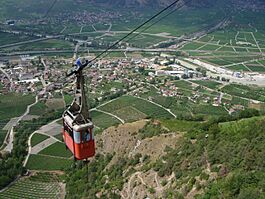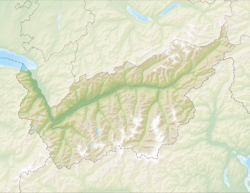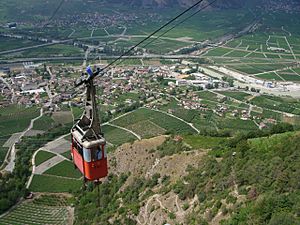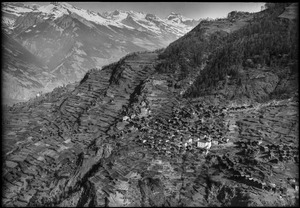Isérables facts for kids
Quick facts for kids
Isérables
|
||
|---|---|---|
 |
||
|
||
| Country | Switzerland | |
| Canton | Valais | |
| District | Martigny | |
| Area | ||
| • Total | 15.25 km2 (5.89 sq mi) | |
| Elevation | 1,106 m (3,629 ft) | |
| Population
(Dec 2020 )
|
||
| • Total | 827 | |
| • Density | 54.23/km2 (140.45/sq mi) | |
| Postal code |
1914
|
|
| Surrounded by | Nendaz, Riddes | |
Isérables is a small town, also called a municipality, located in the Martigny district of Switzerland. It's found in the beautiful Valais canton, high up in the mountains.
Contents
A Look Back in Time
Isérables has a long history! The town was first written about in official papers way back in 1227. Back then, it was called Aserablos. Later, in 1324, its name changed slightly to Yserablo.
Exploring Isérables' Geography
Isérables covers an area of about 15.3 square kilometers (about 5.9 square miles). A big part of this land, about 50.4%, is covered by forests. About 22.1% of the land is used for farming. Only a small part, 2.7%, has buildings or roads. The rest, 24.8%, is land that can't be used for much.
This mountain town is located in the Martigny district. It sits high above the town of Riddes, on the left side of the Rhône River.
Isérables' Coat of Arms
The coat of arms for Isérables has a special design. It is split into two parts: one blue and one gold. On top of these colors, there is a green maple leaf. The bottom part shows green hills.
This maple leaf is a clever design trick called "canting arms". In French, the word for maple is érable, which sounds a lot like "Isérables". It's like a visual pun!
Who Lives in Isérables?
Isérables has a population of about 982 people. Most people in Isérables, about 99.8%, speak French as their main language. A very small number of people speak German.
In 2008, about 2.2% of the people living in Isérables were from other countries. Over the past ten years (from 2000 to 2010), the number of people living here has gone down a little bit.
When we look at the age groups, about 21.9% of the population are children and teenagers (0–19 years old). Adults (20–64 years old) make up 60% of the population. People over 64 years old make up 18.2%.
Most people living in Isérables in 2000 were born there, about 84.4%. Others were born in the same canton (7.1%) or other parts of Switzerland (2.3%). A small number, 2.1%, were born outside Switzerland.
The chart below shows how the population of Isérables has changed over many years:

Important Sights
The entire village of Isérables is considered a special place. It's part of the Inventory of Swiss Heritage Sites. This means its unique look and history are protected.
How People Make a Living
In 2010, the unemployment rate in Isérables was 4.7%. This means a small number of people who wanted to work couldn't find jobs.
Many people in Isérables work in different types of jobs:
- Primary Sector: This includes jobs like farming. About 89 people worked in this area, with 38 businesses.
- Secondary Sector: This involves making things, like in factories or construction. About 69 people worked here, with 9 businesses.
- Tertiary Sector: These are service jobs, like working in shops, hotels, or transportation. About 70 people worked in this sector, with 21 businesses.
In 2000, many people who lived in Isérables traveled to other towns for work. About 267 people left the municipality to work, while only 61 people came into Isérables for their jobs. Most people (58.7%) used a private car to get to work, and 7.8% used public transportation.
Religion in Isérables
According to a census in 2000, most people in Isérables, about 93.8%, were Roman Catholic. A small number, 0.8%, belonged to the Swiss Reformed Church. There were also a few people who followed other Christian churches, Islam, or Buddhism. About 1.97% of the population said they didn't belong to any church.
Learning and Education
In Isérables, about 24.4% of the people have finished their non-mandatory upper secondary education. This is like high school. A smaller group, about 2.5%, have gone on to get more education, either at a university or a specialized college.
In 2000, 54 students from Isérables went to schools outside of the municipality.
See also
 In Spanish: Isérables para niños
In Spanish: Isérables para niños






